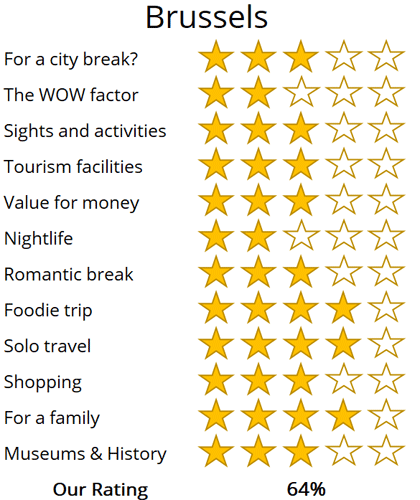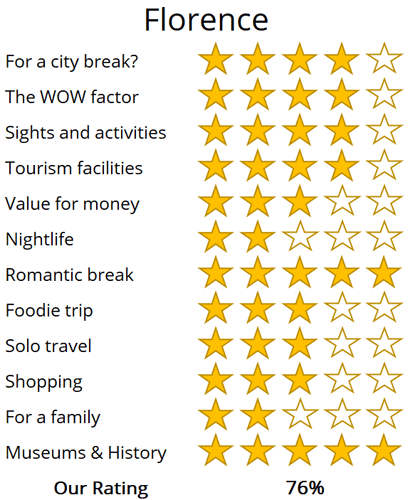WhereToGoForMyHoliday.com
The best destination comparison site!
WhereToGoForMyHoliday.com
The best destination comparison site!
Brussels or Florence, which is better for your holiday in 2024?
Florence and Brussels both offer unique and enticing experiences, but which one should you choose for your city break or holiday?
We recognise the difficulty in making this decision. While there is abundant information available on both destinations, clear guidance on which city better aligns with your travel preferences is often hard to find.
This article aims to provide an impartial comparison of Florence and Brussels, and hopefully help you to choose the best city to visit.
The article is structured into several sections, each of which can be directly accessed through the following links:
• Introduction to the cities
• Scores and ratings
• Which one should I, friends, or family visit?
• When to visit and weather
• Who is the city suited for?
• The perfect 48hours (with map)
• Tourism details (where to stay? airport details?)
Introduction to Brussels and Florence
Florence comes at you in a flurry of priceless art, pastel-painted jewellers, romantic piazzas, marble-gilded basilicas, and saffron-scented risotto. Nestled into the rolling Arezzo hills in the northern part of Tuscany, this is the very birthplace of the European Renaissance.
Florence flows in its 15th-century brilliance; there’s the Uffizi Gallery - home to works by Michelangelo and Sandro Botticelli - and the handsome Ponte Vecchio bridge.
Delve beneath the famed sights and Florence is a lived-in Italian metropolis. Locals devour lampredotto sarnies while glugging Chianti reds in hidden trattoria.
Florence’s allure is as classical as the city itself, but be warned you will be sharing the experience with many others, as there will be crowds!
It is all too easy to over-look Brussels as a city break destination, especially considering it is the home of modern European politics. However, there is a surprising amount here to explore and enjoy, and a visit here can end up being one of those unexpected hits that with hindsight, you can’t understand why you hadn’t been before.
Being smaller than many of its European counterparts it is able to offer the perks of a more manageable and friendly atmosphere with fewer crowds, exceptional art galleries, museums and medieval churches abundant around every cobbled street corner. It is also brimming with quirky café charm and home to the highest standard of food you will find anywhere in the world.

The Mont des Arts gardens in central Brussels
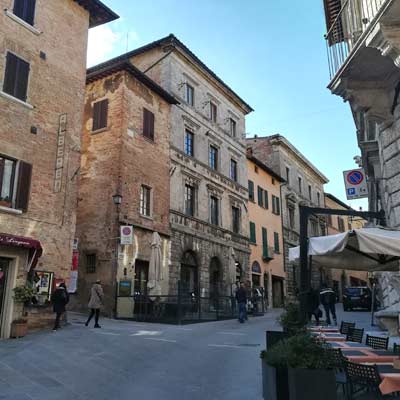
Every street in Florence is characterful
High-level summary for Brussels and Florence
Summary
Where would I journey for a personal escape?
Florence
Where would I send my parents for a memorable visit?
Florence
Where's the ideal destination for my adventurous 19-year-old cousin?
Florence
Where should my food-obsessed friend indulge their culinary passions?
Florence
Note: The above comparisons are weather-independent and are based on travel during the most opportune times of the year. Details about the ideal travel seasons are elaborated upon later in this article.
In the sections that follow, you'll find a comprehensive comparison between these two fascinating cities. This includes recommendations on the duration of stay, the best times to visit, and tailored 48-hour itineraries for each city.
The final segment delves into practicalities for your travels, such as the best airport to fly into, the optimal districts for your accommodation, and insider tips, for when you come to explore the city.
We hope that you find all of this information useful, in planning your next exciting trip!
Destination details
How long to spend each city?
Brussels, with its compact layout, allows visitors to explore its main attractions within 1 or 2 days, primarily centered around the historical core.
A leisurely stroll from the Grote Markt (The Grand Place), the heart of the city, to the EU Parliament, passing through the lively Stalingrad District, takes just a couple of hours—though this may vary depending on your penchant for Belgian beer stops along the way!
If time permits, consider day trips to the historic battlefield of Waterloo or the charming medieval city of Bruges, both offering unique insights into Belgium’s rich heritage.
Florence demands at least two days. Lovers of this enchanting town will surely scoff at that. They wax lyrical about how Florence seduces folk who pass its way into staying weeks, months, years, and even whole lifetimes. Still, we think it's possible to check off the main sights, try the top dishes, and explore the historic center with around 48-72 hours total.
In the peak season there are extremely long queues for the galleries and Duomo cathedral; to avoid wasting precious time, it is advisable to pre-purchase tickets and start the day sightseeing very early (before 8am).
There are many good day trips from Florence, which are easily accessible by train, and include Siena, Lucca, and Arezzo. Florence may be a smaller city, but a fabulous one-week holiday could be had based here.

The Saint Jacques-sur-Coudenberg church, Brussels
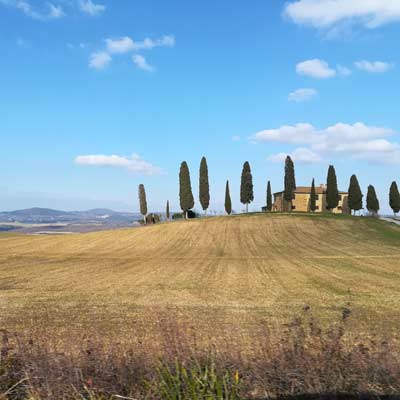
Tuscany is a beautiful region to discover
Brussels gets busiest during the warm months of the summer. Everyone from city breakers flying in on short-haul budget links to Interrail backpackers on a cross-continent grand tour pass through during the main holidays from June and August.
There's a real buzz about the bars of the Grand Place then, with people chatting and snapping selfies all around the UNESCO-tagged streets. Some downsides: Brussels can have heatwaves, and the price of hotels at this time is sure to be peaking.
While winter is probably best avoided unless you're on the hunt for cosy Christmas markets, spring and autumn have their pluses. They're both typically cheaper. There's fewer people around, so you're more likely to score tours of the EU Parliament and whatnot. And everything costs a little less, from hotels to flights deals into town.
You've got to remember that Florence is up there with the most famous in Italy, and the vast majority of the 15.4 million visitors that come annually turn up in the summer months! That sends hotel rates skywards between June and August and means you'll need to jostle for space in front of Giotto's Bell Tower and the Duomo.
The ideal time to visit Florence is from April to June or September and October. They have good weather, fewer people, and cheaper prices, not to mention food festivals and wine harvest events. Winters are cooler and possibly wet but have the lowest number of tourists.
Culture and art are the pillars of Florence. Lovers of the late Middle Ages and the Renaissance will feel right at home between the Accademia Gallery and the Uffizi. Within their halls are iconic sculptures like Michelangelo's David, The Birth of Venus by Botticelli, and Caravaggio's haunting Medusa. And that's only scratching the surface!
Adding to the mix are the intriguing collections of the Museo Galileo for science buffs, the Ponte Vecchio for architecture aficionados, and tasty Tuscan farm foods for gourmands. Downsides include high visitor numbers, so it's best to steer clear if you're not a fan of crowds, particularly in the summer.
Florence is not an overly expensive destination, is relatively safe and has a small city atmosphere.
One of the great joys of Brussels is just how many facets there is to the city. You're certain to be entertained if you love architecture. The main square alone comes with Gothic, Neo-Gothic, and Renaissance elements.
Then there's all that fabled Belgian food, from the double-cooked chips to the chocolate-topped waffles to the frothy monk-brewed beers you find in the pubs. Add in enthralling tours of important parliament buildings, pretty parks, and some seriously rich galleries, and you've got a destination suited to all sorts.
Of course, some people might not feel right at home, Brussels is urban to the core. Finally, budget seekers could find themselves a little happier elsewhere. Brussels hardly breaks the bank, but it's no penny saver either.

The Arc de Triomphe leads to the Park du Cinquantenaire
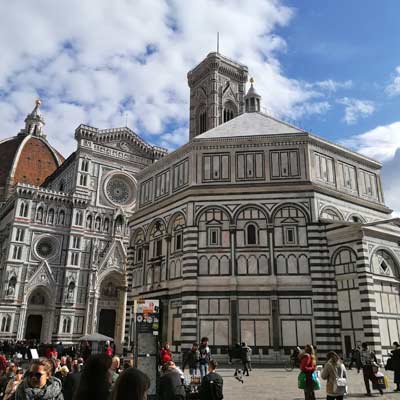
The Duomo has a gothic design, but the façade is covered in red green and white marble
48hours in Brussels
A whirlwind 48 hours in Brussels can take you from curious statues to modernist structures, regal parklands to beautiful palaces. Of course, there's plenty of time to fit in home-brewed beers and indulgent waffles along the way.
Day 1: The Grand Place is the only real place to begin in Brussels. A UNESCO World Heritage Site, it is the kernel of the city, and has been since time immemorial. Look to the north end and you can see the elegant façade of the Brussels City Museum. It's housed in the Neo-Gothic Maison du Roi, hosting collections that include masterworks by Flemish painters and the original Manneken Pis statue (more on him later).
On the south flank is the indomitable Brussels Town Hall. Gaze up at its gorgeous medievalist spire and wonder at the carvings of dukes on the portals. The rest of the square is a photographer's dream, with guild houses and pubs and more. Next, the area of Stalingrad calls. Curiously named, it's nonetheless one of the liveliest quarters of Brussels.
It's also where you'll find the famously underwhelming Manneken Pis statue – we won't spoil it with a description! After lunching in one of the taverns there, head east to the acclaimed Royal Museum of Fine Arts of Belgium. It's a must for any culture vultures, what with exhibits that contain works by the likes of Anthony van Dyck, Bruegel, and Rubens. It demands a whole afternoon.

The town hall on the Grand Place, the main plaza of Brussels
Day 2: Overdosed on art and ready for something completely different? Good, because day two begins at the Espace Léopold. Welcome to the vast European Parliament; the corridors of power for 27 states that range from Romania to Portugal. Tours of the huge debating chamber and the plenary rooms where the decisions are made run daily from 9am.
After an hour inside, you can head for the grand Parc du Cinquantenaire that sits just behind. It's a prime example of Brussels' flamboyant public garden style, hosting the eye-watering Arc du Cinquantenaire, a national symbol of Belgium.
The afternoon sees you hop on trams (a combo of Tram 5 and Tram 6 usually does the trick) to the area of Laeken. This otherwise green a leafy suburb has one major claim to fame: the strange Atomium. You might not believe it, but it was built in 1958. Up top there's a lookout point with panoramas of the whole city.
For the evening, mosey back to the Grand Place and seek out the iconic Delirium Café on the side streets nearby. It's home to a whopping 2,000 variations of Belgian and global beers!

Brussels is the home to the European Parliament
48 hours in Florence
Early morningstarts are key in Florence, to hit the galleries and basilicas before the crowds. Don't worry, though, this two-day itinerary has time to rest with beautiful views in Renaissance gardens come the afternoon…
Day 1: Make for the Piazza del Duomo for the break of dawn – seriously, the earlier you can get there the better. That way, you can snap shots of the great cathedral and adjacent Giotto's Bell Tower without plumes of visitors getting in the way!
Look to the green-white marble inlays and the striking Gothic Revivalism of the whole building and think about hitting the 87-meter high lookouts of the belfry for some sweeping views across the city and the Apennines.
Traditional Tuscan design oozes from the lovely Palazzo Vecchio on Piazza della Signoria – this is the town hall, dating from way back in the 1400s. Grab an on-the-go pizza slice and make north to Galleria dell'Accademia after that.
A quick in and out there should be enough to appreciate the wonderful David statue by Michelangelo, before hopping back to the riverside and crossing the Ponte alle Grazie (have the camera ready).
For sunset, a climb to the Piazzale Michelangelo is a must. The panoramas include the Tuscan hills and the pastel-painted tops of the city, which look stunning as the light dips low.
For dinner try the regional meal of Bistecca alla Fiorentina (Florentine steak).

The shops along the Ponte Vecchio traditionally sold jewellery
Day 2: It's a museum morning in the famous Uffizi Gallery on day two. For art lovers, the journey here is a rite of passage. The collections span several wings of a great palace in the heart of central Florence and can take hours on end to appreciate fully.
Highlights that simply can't be missed include The Birth of Venus (Botticelli), Laocoön and his Sons (Bandinelli), Raphael's portrait of Pope Leo X, and Caravaggio's unforgettable Medusa. Back outside, the Ponte Vecchio bridge isn't far. It was once a butcher's market but is now famous for its jewellery boutiques.
On the hills beyond are the handsome Boboli Gardens, all brimming with babbling fountains and carved statues. Further up again is Forte di Belvedere, where even more breathtaking views of Florence are on offer come the evening.
Related articles: Florence in 2 days

The Uffizi Gallery exhibits the greatest collection of Renaissance art

The statue of David is regarded Michelangelo finest work
Florence
The best place to touchdown on a flight is surely Amerigo Vespucci International Airport. A mere 15 minutes' drive (7km) in a taxi, or 30 minutes in a train, can link you from the downtown to the terminals there.
Unfortunately, the bulk of Europe's budget carriers will jet into Pisa. That's still close – around 1-1.5 hours (83km) in the bus to the west.
Avoid flying into Bologna, as this is even further away (115km), and bus transfer 1.5-2 hours.
You definitely won't have to worry about finding somewhere to stay. From slick boutique hotels to simple hostels, Florence has all sorts. The town's primary industry is tourism, after all. Just expect prices to soar in the middle of the summer, before dropping again around the start of September.

The Piazza della Signoria
In terms of neighborhoods, you'll want to focus on bedding down within the SS67 ring road. More specifically, the districts of San Giovanni (the historic core) and Santa Croce are perhaps the most central, even if the latter retains a lived-in Italian feel. San Marco is a whisker to the north, hosting the bulk of the low-cost hotels and guest houses. Oltrarno boasts buzzy nightlife venues and hip coffee shops.
Related articles: Where to stay in Florence?
You probably won't need any forms of transport in Florence other than your own two feet. The town is eminently walkable. Be sure to bring comfy shoes that are suited to long days, however, especially if you're keen to scale to the lookout points around Piazzale Michelangelo.
For exploring the surrounding region, a rental car is a must. These tend to be cheap in Italy and are best organised from the airport to avoid driving through the centre of town.
Aside from the infamous Stendhal syndrome – a condition supposedly caused by exposure to too much beautiful Florentine art – there are no standout risks to visiting this city. The centre is generally safe and well maintained, crime rates are relatively low, and the locals are often happy to help out.
Brussels Airport (BRU) and the Charleroi Airport (CRL) combine to offer all sorts of long-haul and short-haul air links into the capital. The cheapest cross-continent flights on Ryanair and the like usually jet into CRL. Transatlantic and premium carriers usually go to BRU.
You can use Brussels City Shuttle to get to Charleroi for as little as €5 each way if booked online and in advance. Meanwhile, direct rail links go to Brussels Airport from Brussels Central, costing €8.60 and taking a little over 20 minutes in total.
Most of the sights and attractions on the itinerary above are within walking distance of each other. But be ready to make use of Brussels' efficient public transport system if the legs tire and the rain starts falling, though.
The metro and high-speed tram network links up most areas with its six lines. Tickets can be bought at the GO machines on virtually every station. They need to be validated at the orange boxes before use.

The bars and pubs in the historic centre of Brussels
In terms of travel safety, Brussels ranks well. Incidents involving tourists are rare, although thefts, bag snatches, and pickpocketing do occur in many of the visitor hotspots.
Try not to walk alone in the city centre after dark, particularly if you've been drinking. Never leave valuable items within sight if you're parking your car. Also always keep one eye on your handbag or wallet when riding the metro.
For hotels, the best area of Brussels is surely the district immediately around the Grand Place. The closest establishments to that UNESCO site typically cost oodles but ooze luxury. A few streets back and you can find affordable local B&Bs with plenty of charm.

oh we were stuck in the airport!

Copenhagen was a bit expensive...

All we did was drink beer in Brussels...

Muncih was crazy

And we got so burnt!

Remeber that night in Rome

oh we were stuck in the airport

So much fun kayaking

Berlin and that group from Austria!

There was such a view from that church

And we got so burnt!

Munich was eventful, wasn't it!

Such a view from that cathedral in Florence

Lisbon was such so much fun

Last summer was so much fun .... x

Remeber that night in Rome

Lisbon was such so much fun

Such a view from that cathedral in Florence

Munich was eventful, wasn't it!

And we got so burnt!

Remeber that night in Rome

All we did was drink beer in Brussels...

Berlin and that group from Austria!

Can't wait to go back to Dubrovnik

Remember that boat ride in Prague

Copenhagen was a bit expensive...
